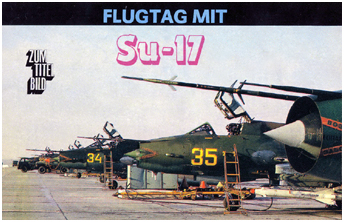
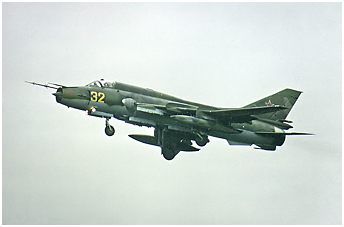 As mentioned at the end of the previous page, the development of the Su-17M3 (Article S-52) "Fitter-H" was launched in the wake of the Su-17UM two-seater version.
The first of five prototypes was ready in early 1976 and the second (currently on display at the Monino Museum) a year later. Stability on the yaw axis left something to be desired when the wings were swept back at the
maximum angle of 63° while flying with a high angle of attack. To remedy this problem, the vertical fin was enlarged with an extension of 145mm above the rudder and a small caudal keel was added under the rear fuselage. These characteristics were implemented on the Su-17UM3 and the Su-17M4. While serial production began in 1976 in parallel with that of the Su-17UM (and later the Su-17UM3) and carried on until 1981 until 450 copies of the "Fitter-H" had come off the production lines, it was only from the 38th series in 1978 that these improvements were introduced during manufacturing. However, the aircraft built previously were also modified accordingly.
The aerodynamic configuration chosen was identical to that of the two-seater with the slightly droop nose. The space that was reserved for the second cockpit on the Su-17UM was now filled with avionics, while the fairing behind it housed a new 285-litre fuel tank. A maximum of four additional PTB-800 or two PTB-1150 drop tanks were likely to increase the range.
Starting from 1979, a zero-zero K-36DM ejection seat equipped the Su-17M3 and later the Su-17M4.
As mentioned at the end of the previous page, the development of the Su-17M3 (Article S-52) "Fitter-H" was launched in the wake of the Su-17UM two-seater version.
The first of five prototypes was ready in early 1976 and the second (currently on display at the Monino Museum) a year later. Stability on the yaw axis left something to be desired when the wings were swept back at the
maximum angle of 63° while flying with a high angle of attack. To remedy this problem, the vertical fin was enlarged with an extension of 145mm above the rudder and a small caudal keel was added under the rear fuselage. These characteristics were implemented on the Su-17UM3 and the Su-17M4. While serial production began in 1976 in parallel with that of the Su-17UM (and later the Su-17UM3) and carried on until 1981 until 450 copies of the "Fitter-H" had come off the production lines, it was only from the 38th series in 1978 that these improvements were introduced during manufacturing. However, the aircraft built previously were also modified accordingly.
The aerodynamic configuration chosen was identical to that of the two-seater with the slightly droop nose. The space that was reserved for the second cockpit on the Su-17UM was now filled with avionics, while the fairing behind it housed a new 285-litre fuel tank. A maximum of four additional PTB-800 or two PTB-1150 drop tanks were likely to increase the range.
Starting from 1979, a zero-zero K-36DM ejection seat equipped the Su-17M3 and later the Su-17M4.
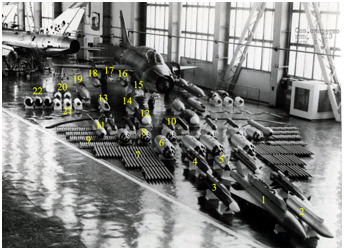
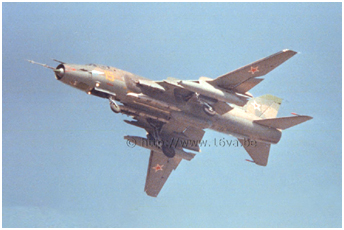 The engine remained the Lyul'ka AL-21F-3 which also powered the Su-17M/M2/UM. The Su-17M3 had the standard armament of two 30mm cannons, while two additional pylons (n°9 and 10) intended solely to carry R-60 air-to-air missiles with IR homing, were added in 1978 between the two wing hardpoints.
Two additional hardpoints n°1r and 2r were located under the forward fuselage. Although apparently located at the same place as the hardpoints n°1 and 2 (refer to the previous page for more details), they were actually offset laterally outward in order to provide more space for the Kh-25., Kh-27PS, Kh-58U and Kh-29L missiles that they were intended to carry (see photo above left). This, therefore, brought the total number of hardpoints to 15 compared to 11 for the Su-7M2.
Once some accuracy problems were resolved, a new ASP-17BMTs HUD replaced the old ASP-17S.
The Fon laser rangefinder in the nose cone on the Su-17M2 gave way to the laser rangefinder and target designator Klen-PS (S for Sukhoy) identical to the Klen-PM (M for MiG) mounted in the MiG-27M and D. The laser beam of the Klen-PS could be pointed in front of the aircraft at an angle ranging from +6° to -30° compared to 0° to -17° for the Su-17M2.
Regarding self-defense, in addition to the R-60 missiles, the SPO-15L Bereza-L radar detection and warning system was installed.
The first aircraft were still equipped with the SRO-2M Khrom IFF system that was later replaced with the SRO-1P Parol'.
Two KDS-23 flare launcher cassettes containing six rounds each (PPI-50 thermal or PRP-50 dipole reflectors) were housed internally, on the back of the fuselage behind the cockpit.
The possible addition of four sets of ASO-2V flare launchers on top of the fuselage stemmed from the experience of the Afghanistan war.
Carrying an ECM nacelle of course remained relevant. However, the SPS-141MVG (or SPS-142MVG) automatic jammer, intended to counter the MIM-23 Hawk missiles, replaced the SPS-141V.
The first Su-17M3, however, still used the older ECM system. The left cannon was disabled when an ECM pod was mounted to prevent damage to it.
The engine remained the Lyul'ka AL-21F-3 which also powered the Su-17M/M2/UM. The Su-17M3 had the standard armament of two 30mm cannons, while two additional pylons (n°9 and 10) intended solely to carry R-60 air-to-air missiles with IR homing, were added in 1978 between the two wing hardpoints.
Two additional hardpoints n°1r and 2r were located under the forward fuselage. Although apparently located at the same place as the hardpoints n°1 and 2 (refer to the previous page for more details), they were actually offset laterally outward in order to provide more space for the Kh-25., Kh-27PS, Kh-58U and Kh-29L missiles that they were intended to carry (see photo above left). This, therefore, brought the total number of hardpoints to 15 compared to 11 for the Su-7M2.
Once some accuracy problems were resolved, a new ASP-17BMTs HUD replaced the old ASP-17S.
The Fon laser rangefinder in the nose cone on the Su-17M2 gave way to the laser rangefinder and target designator Klen-PS (S for Sukhoy) identical to the Klen-PM (M for MiG) mounted in the MiG-27M and D. The laser beam of the Klen-PS could be pointed in front of the aircraft at an angle ranging from +6° to -30° compared to 0° to -17° for the Su-17M2.
Regarding self-defense, in addition to the R-60 missiles, the SPO-15L Bereza-L radar detection and warning system was installed.
The first aircraft were still equipped with the SRO-2M Khrom IFF system that was later replaced with the SRO-1P Parol'.
Two KDS-23 flare launcher cassettes containing six rounds each (PPI-50 thermal or PRP-50 dipole reflectors) were housed internally, on the back of the fuselage behind the cockpit.
The possible addition of four sets of ASO-2V flare launchers on top of the fuselage stemmed from the experience of the Afghanistan war.
Carrying an ECM nacelle of course remained relevant. However, the SPS-141MVG (or SPS-142MVG) automatic jammer, intended to counter the MIM-23 Hawk missiles, replaced the SPS-141V.
The first Su-17M3, however, still used the older ECM system. The left cannon was disabled when an ECM pod was mounted to prevent damage to it.
| ORBAT 1976 - 1994 |
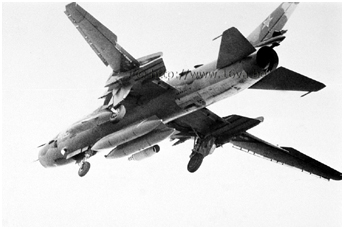
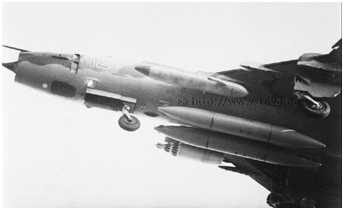 The weapons range of the "Fitter-H" naturally took up a large part of that of the Su-17M2, i.e., conventional bombs - theoretically up to four tons (eight 500kg bombs under the hardpoints 1 to 8) - the ZB-500 incendiary bombs or the KMGU-1 and -2 cluster munitions containers.
The nuclear configuration included either a single RN-24 bomb (500kg), two RN-28 bombs (305kg), or two RN-40 bombs under the fuselage (hardpoints 1s and 2s) plus two PTP-1150 drop tanks under the wings.
It was only starting with the Su-17M3 version and its ASP-17B collimator associated with a control interface, that the SPPU-22 pod could be used with its GSh-23L 20mm twin-barrel cannon inclined downwards.
The cannons could be pointed towards the ground at an angle of up to 30° with the barrels facing forward, or with the cannon pointing backwards when the pod was turned around. The cannons were fired at low altitude while in level flight, at 1400 to 1600 meters from the target. When the correct firing mode was activated, the pilot lined up the reticle on the target and pulled the trigger, the gun automatically firing at the right time at the angle of inclination set while on the ground. The procedure remained the same when the barrel was turned towards the rear, the firing delay being calculated automatically. However, for example, using this weapon for dropping bombs during the same attack required that the pilot juggle the weapons syste's controls. This problem was solved with the Su-17M4 that allowed the simultaneous use of the SPPU while continuing the attack with another weapon.
The weapons range of the "Fitter-H" naturally took up a large part of that of the Su-17M2, i.e., conventional bombs - theoretically up to four tons (eight 500kg bombs under the hardpoints 1 to 8) - the ZB-500 incendiary bombs or the KMGU-1 and -2 cluster munitions containers.
The nuclear configuration included either a single RN-24 bomb (500kg), two RN-28 bombs (305kg), or two RN-40 bombs under the fuselage (hardpoints 1s and 2s) plus two PTP-1150 drop tanks under the wings.
It was only starting with the Su-17M3 version and its ASP-17B collimator associated with a control interface, that the SPPU-22 pod could be used with its GSh-23L 20mm twin-barrel cannon inclined downwards.
The cannons could be pointed towards the ground at an angle of up to 30° with the barrels facing forward, or with the cannon pointing backwards when the pod was turned around. The cannons were fired at low altitude while in level flight, at 1400 to 1600 meters from the target. When the correct firing mode was activated, the pilot lined up the reticle on the target and pulled the trigger, the gun automatically firing at the right time at the angle of inclination set while on the ground. The procedure remained the same when the barrel was turned towards the rear, the firing delay being calculated automatically. However, for example, using this weapon for dropping bombs during the same attack required that the pilot juggle the weapons syste's controls. This problem was solved with the Su-17M4 that allowed the simultaneous use of the SPPU while continuing the attack with another weapon.
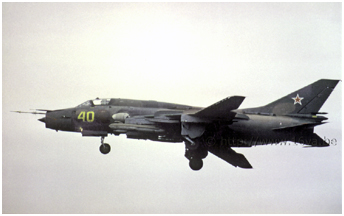
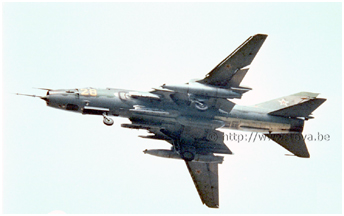 While the Su-17M3 could still fire Kh-23/M missiles guided by a Del'ta-NG pod, the use of Kh-25L or ML laser-guided missiles (usually two missiles under the outer wing hardpoints n°3 and 4) and Kh-29L (from 1979-80 - two missiles under the belly - hardpoints 1r and 2r) no longer required a Prozhektor-1 pod since the Klen-PS could designate the target.
In addition to the S-5 unguided rockets (UB-16-57UM and UB-32A pods), S-8 (B-8M1 pod), S-13 (B-13 pod), S-24 (APU-68U rail ) and S-25 (O-25 tube), a laser-guided version of the latter became available beginning in 1979.
Needless to say, the accuracy of an S-25L was considerably superior to the unguided variants of this rocket.
The Kh-28 anti-radar missile and its Metel'-A designation pod remained relevant. However, three new types of anti-radar missiles entered service. They were more practical to use because they were less bulky and used a solid propellant. The first one was the Kh-25MP with a range of around 10 km, targeting in particular the "Hawk", "Improved Hawk," and "Nike Hercules" systems. The Kh-25MPU version was also aimed at the "Roland" and "Crotale" systems. However, its range was considerably increased so it could be launched outside the lethal zone of surface-to-air missiles, going up to 40 km. It was equipped with a passive radar seeker (PRGSN) intended to track radar waves emitted continuously.
While the Su-17M3 could still fire Kh-23/M missiles guided by a Del'ta-NG pod, the use of Kh-25L or ML laser-guided missiles (usually two missiles under the outer wing hardpoints n°3 and 4) and Kh-29L (from 1979-80 - two missiles under the belly - hardpoints 1r and 2r) no longer required a Prozhektor-1 pod since the Klen-PS could designate the target.
In addition to the S-5 unguided rockets (UB-16-57UM and UB-32A pods), S-8 (B-8M1 pod), S-13 (B-13 pod), S-24 (APU-68U rail ) and S-25 (O-25 tube), a laser-guided version of the latter became available beginning in 1979.
Needless to say, the accuracy of an S-25L was considerably superior to the unguided variants of this rocket.
The Kh-28 anti-radar missile and its Metel'-A designation pod remained relevant. However, three new types of anti-radar missiles entered service. They were more practical to use because they were less bulky and used a solid propellant. The first one was the Kh-25MP with a range of around 10 km, targeting in particular the "Hawk", "Improved Hawk," and "Nike Hercules" systems. The Kh-25MPU version was also aimed at the "Roland" and "Crotale" systems. However, its range was considerably increased so it could be launched outside the lethal zone of surface-to-air missiles, going up to 40 km. It was equipped with a passive radar seeker (PRGSN) intended to track radar waves emitted continuously.
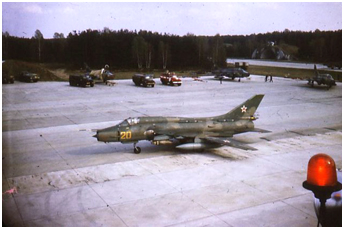
 Then there was the Kh-27PS developed from the Kh-25. Its passive sensor was interchangeable depending on the type of threat to be dealt with. It could steer to the target not only by following the radar waves, but also by the side lobes. It was able to re-acquire the target or another nearby in the event of a temporary interruption of radar emissions.
This missile was used by the MiG-27 and the Su-17M3 from 1980. The Kh-25MP and Kh-27PS could not be fired without the help of a BA-58 V'yuga-17 pod (Article L-086) bolted under the belly of the "Fitter" in the fuselage axis. The presence of this bulky container disturbed the stability of the plane. While the V'yuga pod of the "Flogger" had a cylindrical shape, that of the Su-17 was wide and flattened. Target attack parameters such as the missile flight profile - altitude gain and dive angle - had to be programmed into the pod before flight to be fed into the missile autpilot. A light display called Luch (Beam) provided the pilot with information about the various parameters related to the missile firing.
The third type of missile which deserved the term "fire and forget" was the Kh-58U, already studied in detail on the page dedicated to the MiG-25BM (>
Link). That missile with a maximum range of at least 100 km (longer or shorter depending on the firing profile) also required that a V'yuga-17 pod be carried. It was added to the Su-17M3 weapons range around 1980.
Then there was the Kh-27PS developed from the Kh-25. Its passive sensor was interchangeable depending on the type of threat to be dealt with. It could steer to the target not only by following the radar waves, but also by the side lobes. It was able to re-acquire the target or another nearby in the event of a temporary interruption of radar emissions.
This missile was used by the MiG-27 and the Su-17M3 from 1980. The Kh-25MP and Kh-27PS could not be fired without the help of a BA-58 V'yuga-17 pod (Article L-086) bolted under the belly of the "Fitter" in the fuselage axis. The presence of this bulky container disturbed the stability of the plane. While the V'yuga pod of the "Flogger" had a cylindrical shape, that of the Su-17 was wide and flattened. Target attack parameters such as the missile flight profile - altitude gain and dive angle - had to be programmed into the pod before flight to be fed into the missile autpilot. A light display called Luch (Beam) provided the pilot with information about the various parameters related to the missile firing.
The third type of missile which deserved the term "fire and forget" was the Kh-58U, already studied in detail on the page dedicated to the MiG-25BM (>
Link). That missile with a maximum range of at least 100 km (longer or shorter depending on the firing profile) also required that a V'yuga-17 pod be carried. It was added to the Su-17M3 weapons range around 1980.
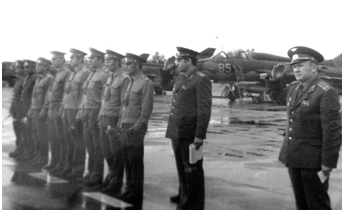
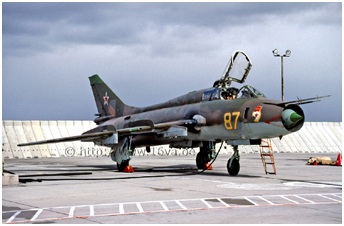 Two missiles could be attached to AKU-58-1 pylons under the forward fuselage (hardpoints 1r and 2r), while an SPS-141MVG ECM pod was mounted under the left outer wing hardpoint n°3 (usually under the inner one in other configurations) and, normally, a UB-32M rocket launcher pod mounted on the right side counterbalanced it. Unlike other missiles whose nose dielectric fairing was made of fiberglass, that of the Kh-58U was made of glass, requiring special attention from ground personnel! In 1981, the "Fitter-H" produced from the 54th series would have been assigned the designation Su-17M3P (S-52P). These aircraft had the required standards to be equipped with a reconnaissance nacelle (see the 294.ORAP > Link) or fire Kh-25MP, Kh-27PS, and Kh-58U missiles. Previously built planes were modified in maintenance centers.
The Su-22M (S-52K - weapons system of the Su-22 and R29BS-300 reactor) and Su-22M3 (S-52M3K - weapons system of the Su-17M3 and R29BS-300 reactor) were the export versions of the Su-17M3.
Two missiles could be attached to AKU-58-1 pylons under the forward fuselage (hardpoints 1r and 2r), while an SPS-141MVG ECM pod was mounted under the left outer wing hardpoint n°3 (usually under the inner one in other configurations) and, normally, a UB-32M rocket launcher pod mounted on the right side counterbalanced it. Unlike other missiles whose nose dielectric fairing was made of fiberglass, that of the Kh-58U was made of glass, requiring special attention from ground personnel! In 1981, the "Fitter-H" produced from the 54th series would have been assigned the designation Su-17M3P (S-52P). These aircraft had the required standards to be equipped with a reconnaissance nacelle (see the 294.ORAP > Link) or fire Kh-25MP, Kh-27PS, and Kh-58U missiles. Previously built planes were modified in maintenance centers.
The Su-22M (S-52K - weapons system of the Su-22 and R29BS-300 reactor) and Su-22M3 (S-52M3K - weapons system of the Su-17M3 and R29BS-300 reactor) were the export versions of the Su-17M3.
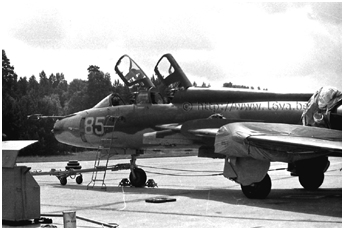
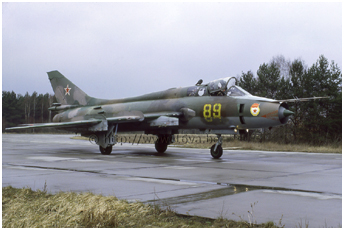 The 20.GvAPIB replaced its Su-17M with Su-17M3 during the spring of 1980. As we saw on the previous page, the Su-17M based in Gross Dölln then joined the ranks of the 730.APIB in Neuruppin.
Personnel of the 20.GvAPIB first squadron attended the theoretical courses in Lipetsk beginning in April. The pilots then went to Komsomol'sk-on-Amure to take charge of four new Su-17UM3. The latter joined the GDR in flight between June 16 and 20. More aircraft, single and two-seaters, also joined Gross Dölln in flight, until the regiment was at full strength in mid-October 1980.
The 20.GvAPIB replaced its Su-17M with Su-17M3 during the spring of 1980. As we saw on the previous page, the Su-17M based in Gross Dölln then joined the ranks of the 730.APIB in Neuruppin.
Personnel of the 20.GvAPIB first squadron attended the theoretical courses in Lipetsk beginning in April. The pilots then went to Komsomol'sk-on-Amure to take charge of four new Su-17UM3. The latter joined the GDR in flight between June 16 and 20. More aircraft, single and two-seaters, also joined Gross Dölln in flight, until the regiment was at full strength in mid-October 1980.
Tests of a Su-17UM equiped with a Su-17M3 weapons system began in September 1978. The production of 130 of the new aircraft designated Su-17UM3 (Article S-52UM3) "Fitter-G" had already begun and continued until 1983. The Su-17UM produced previously were gradually brought up to meet the new standards by the maintenance centers. Beside the weapons system, the Su-17UM3 had slight external differences compared to its predecessor. Like the Su-17M3, its vertical tail fin was enlarged, and a keel was mounted under the rear fuselage. The KDS-23 flare launcher cassettes were not mounted. However, ASO-2V flare launchers could be mounted on the back of the fuselage as on the
single seaters. While the Su-17UM3 was capable of carrying out nuclear strikes, it carried one ton less than its single-seat version, i.e., three tons.
The Su-22UM3 (S-52UM3K) equipped with an R-29BS-300 reactor, of which only a handful were manufactured, was the first export version of the Su-17UM3. Most of the production then focused on the Su-22UM3K with an AL-21F-3 engine.
 |
Plan du site - Sitemap |  |
